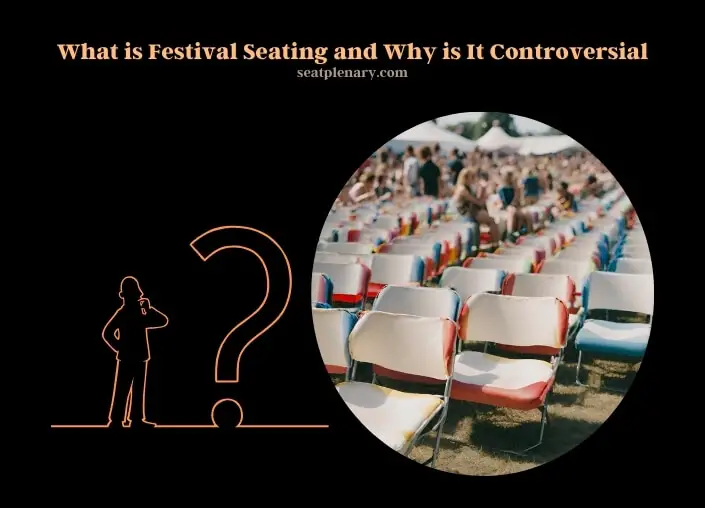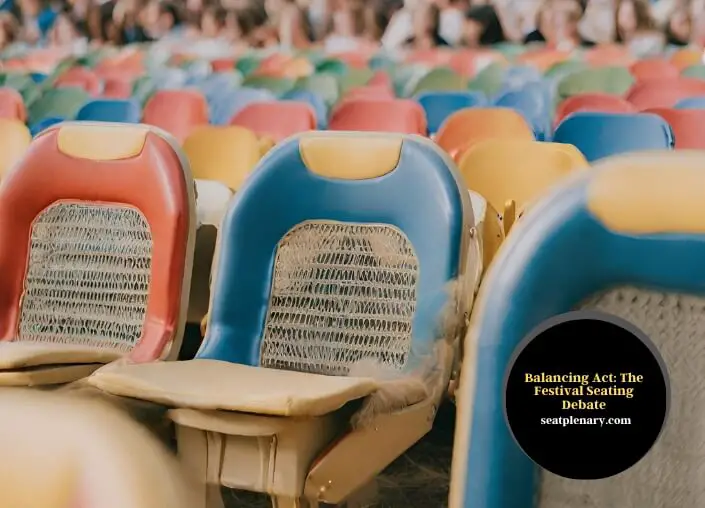Festival seating refers to a general admission approach where attendees can choose their spots on a first-come, first-served basis. It is controversial due to safety concerns, including the risk of overcrowding and stampedes.
Festival seating, while offering an egalitarian and dynamic event experience, has been at the center of debates over safety and accessibility. This seating arrangement allows for a fluid and interactive atmosphere, often preferred by attendees seeking a more immersive experience. The flexibility to move and choose one’s viewing position can enhance the enjoyment of live performances, creating a unique sense of community among the audience.
This same lack of structured seating can lead to significant safety risks in the event of an emergency, making efficient evacuations more challenging. The controversy surrounding festival seating intensified following several tragic incidents, leading to calls for stricter regulations and safety measures at large events.

Festival seating raises questions about accessibility for individuals with disabilities, who may find it difficult to secure a suitable spot amidst the rush. Economic considerations also play a role, as this approach can increase ticket sales but potentially raise insurance and legal costs due to the higher risk of accidents.
Environmental impacts and the role of technology in improving safety are increasingly part of the conversation, pointing towards a future where festival seating might retain its appeal while addressing its inherent challenges more effectively.
Festival Seating: A Historical Perspective
Festival seating, often synonymous with general admission, allows attendees to choose their spots on a first-come, first-served basis. This concept isn’t new; it traces back to ancient times when spectators gathered in open spaces for public performances. Over centuries, this informal seating arrangement evolved, adapting to various events like concerts, sports, and public gatherings.
Its simplicity offered an inclusive atmosphere, breaking the barriers of social hierarchy that assigned seating could impose. Yet, as events grew in size and scale, the dynamics of festival seating began to shift, leading to a complex blend of nostalgia and modern-day challenges.
Why Festival Seating Captivates Organizers and Audiences
Event organizers and attendees often favor festival seating for its flexibility and the unique atmosphere it creates. This preference stems from the freedom it offers, allowing guests to move freely and choose their viewing spots. This flexibility often results in a more engaged and energetic audience, contributing to a memorable event atmosphere.
Comparatively, assigned seating restricts movement and can lead to a more subdued environment. The table below highlights the differences between festival and assigned seating, emphasizing the dynamic nature of festival seating.
Navigating the Risks: Safety Concerns in Festival Seating
Despite its appeal, festival seating is not without its controversies, primarily due to safety concerns. The absence of fixed seating can lead to overcrowding and stampedes, especially if the event attracts more attendees than anticipated.
Historical incidents have underscored the potential dangers, prompting organizers and authorities to reconsider safety measures. The tragic events at concerts and festivals have led to stricter regulations and a reevaluation of festival seating practices. The table on major incidents illustrates the need for improved safety protocols.
Balancing Act: The Festival Seating Debate
The ongoing debate around festival seating centers on balancing convenience and risk. Proponents argue that with proper management and safety measures, festival seating can offer an unparalleled event experience. Critics, however, highlight the inherent risks and call for more regulated seating arrangements.
This debate reflects broader concerns about public safety, individual freedom, and the essence of live events. Engaging with public opinion and expert analysis reveals a divided stance, emphasizing the need for a nuanced approach to festival seating.

Looking Ahead: The Evolution of Event Seating
As we look to the future, the conversation around festival seating and its alternatives continues to evolve. Technological advancements and innovative design solutions are paving the way for safer and more flexible seating arrangements. These developments promise to enhance the event experience while addressing safety concerns. The exploration of alternatives suggests a future where the essence of festival seating is preserved, but its risks are significantly mitigated.
FAQs
Impact on Emergency Evacuations
Festival seating, with its lack of fixed seats, raises concerns about the efficiency of emergency evacuations. In scenarios requiring quick exits, the absence of structured pathways can lead to chaos and bottleneck situations, endangering lives.
Studies have shown that well-organized exits and seating can significantly reduce evacuation times. The challenge with festival seating is ensuring that attendees can leave the venue safely in an emergency, a task complicated by the unpredictable nature of large, unstructured crowds.
Accessibility Considerations
One often overlooked aspect of festival seating is its impact on accessibility. While the flexibility of choosing one’s spot might seem advantageous, it can pose significant challenges for individuals with disabilities. The rush to secure a good view can disadvantage those who cannot move quickly or need specific accommodations.
Ensuring equal access and enjoyment for all attendees is a critical concern that event organizers must address, requiring thoughtful planning and dedicated accessible areas within the festival seating arrangement.
Influence on Audience Behavior
Festival seating can significantly influence audience behavior, fostering a sense of community and shared experience among attendees. This communal atmosphere is one of the main attractions of festival seating, as fans bond over their shared interests and the live experience.
This same dynamic can also encourage risky behavior, such as moshing and crowd surfing, which can lead to injuries. Balancing the communal benefits of festival seating with the need for safety is a complex issue that continues to challenge event organizers.
Economic Implications for Event Organizers
From an economic perspective, festival seating can be both a boon and a bane for event organizers. On one hand, it allows for a higher number of tickets to be sold, as the space is not limited by fixed seating.
On the other hand, the potential for safety incidents and the subsequent legal and insurance costs can offset these financial benefits. The economic implications of choosing festival seating over assigned seating are multifaceted, involving considerations of revenue, safety costs, and reputation management.
Environmental Impact of Festival Seating
The environmental impact of festival seating is an area of growing concern. Without fixed seats, attendees are more likely to move around and potentially contribute to greater wear and tear on the venue’s natural landscape.
The cleanup after events can be more challenging, with litter spread over a wider area. Event organizers are increasingly looking for ways to mitigate these environmental impacts, including implementing more sustainable practices and encouraging responsible behavior among attendees.
The Role of Technology in Enhancing Festival Seating Safety
Advancements in technology offer promising solutions to some of the controversies surrounding festival seating. For example, digital ticketing systems can control and monitor crowd sizes more effectively, while RFID wristbands can track attendee movements to prevent overcrowding.
Apps can provide real-time information to attendees about exit routes and safety alerts. These technological tools can enhance the safety and enjoyment of festival seating, addressing some of the key concerns that have historically plagued this seating arrangement.
Summary
Festival seating remains a beloved yet controversial aspect of live events. Its history, appeal, and the debates it sparks reflect broader themes of freedom, safety, and community in public gatherings. As we move forward, the challenge lies in retaining the spirit of festival seating while ensuring the safety and enjoyment of all attendees. The evolution of event seating will likely continue to balance these priorities, guided by innovation and informed by past experiences.
